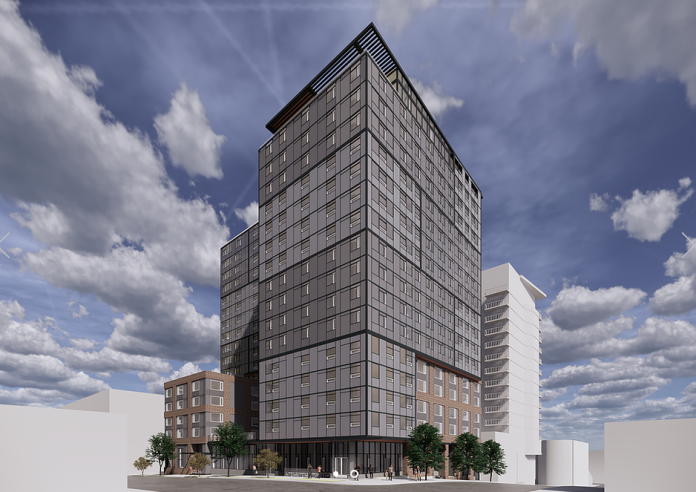
But questions remain about whether or not “Housing Seattle Now” is bold enough to tackle affordable housing woes.
Yesterday at 12th Avenue Arts in Capitol Hill, Mayor Jenny Durkan unveiled what she called “the next chapter of housing in Seattle” to a small crowd of affordable housing advocates. This was the same venue at which Mayor Durkan signed Mandatory Housing Affordability (MHA) into law back in March, and her speech touched on many of the same challenges addressed at the MHA signing ceremony. However, with both MHA and Backyard Cottage Reform now law, the City is angling toward new actions aimed at increasing housing affordability.
“We have to be real about the magnitude of the challenge before us,” Mayor Durkan said, referencing a recent study published by the Federal Reserve Bank of Philadelphia, which named Seattle as the third fastest gentrifying city in the county. She also noted that between 2010 and 2018 average rents for an apartment in Seattle increased by 44%, much faster than wages for most workers, and that this surge in housing cost has contributed to homelessness, racial economic disparity, and displacement of low income residents across the city.
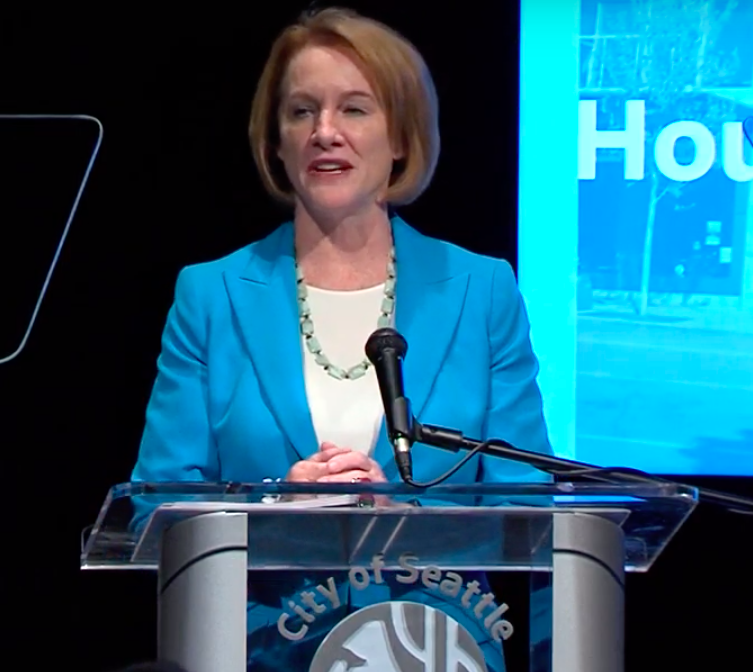
But while the Mayor has described her Housing Seattle Now initiative as “unprecedented,” an initial assessment of plans that have been shared so far suggests a more modest impact.
Currently, several major aspects of the Housing Seattle Now initiative have been identified, which include:
- Extension of the Multi-Family Tax Exemption (MFTE) program;
- A new protection against rent increases for MFTE tenants that limits rent increases to no more than 4.5% per year;
- Investment in permanent supportive housing of at least $50 million dollars raised by bonding off local sales tax, as authorized in HB 1406;
- A detailed plan for the development and sale of a publicly owned parcel of land known as the Mercer Megablock;
- A proposal to use some of the revenue from the sale the Mercer Megablock to fund low-interest loans for backyard cottage or in-law apartment construction;
- Creation of a new program in which the City would strategically purchase property for transit-oriented affordable housing development in locations facing displacement and gentrification;
- Increased protections for renters against evictions or rent increases.
While the list, which is admittedly incomplete at this point, looks substantial when presented together, a more detailed analysis of the individual items reveals they may have limited impact. Unlike her predecessor Ed Murray, Mayor Durkan has been hesitant to make public commitments that come burdened with a hefty price tag, and at times she has expressed frustration at inheriting commitments, such as the Bicycle Master Plan or the Center City streetcar, that she feels overpromised public benefits without actually having funding in place.
MFTE: Workforce housing that keeps getting more expensive

Right now about there are about 4,500 units of rental housing in Seattle that have been kept affordable for workers through the MFTE program, which offers tax incentives to developers who commit to keeping 20-25% of their units affordable for workers earning up to 80% area median income AMI. The Mayor acknowledged in her speech that the program was created to “serve middle class people and families” and while it continues to offer housing to a wide range of working Seattleites, to classify MFTE housing as serving low income Seattleites would be misleading.
The City’s most recently updated comprehensive list of MFTE properties reveals that the bulk of the studio, one bedroom, and two bedroom MFTE units are available to renters earning up to 65%-80% of AMI. For an individual that means $49,400 to $60,800 in annual income.
Only studio units were listed as available to workers earning up to 40% AMI, the lowest eligible income qualification in the program, and according to the City’s comprehensive list, in its entire history the MFTE program produced only 29 affordable studios. For these 29 studios, a single worker earning up to $30,400 would pay $760 in rent monthly.
The picture gets bleaker for working families that might seek to take advantage of the MFTE program. Only 9 three bedroom sized units were listed in the entire MFTE program and zero four bedroom units were listed. Additionally, all of three bedroom units are available to workers earning up to 80%, 85%, or 90% of AMI, which could mean an annual salary of up to $88k for a family of three.
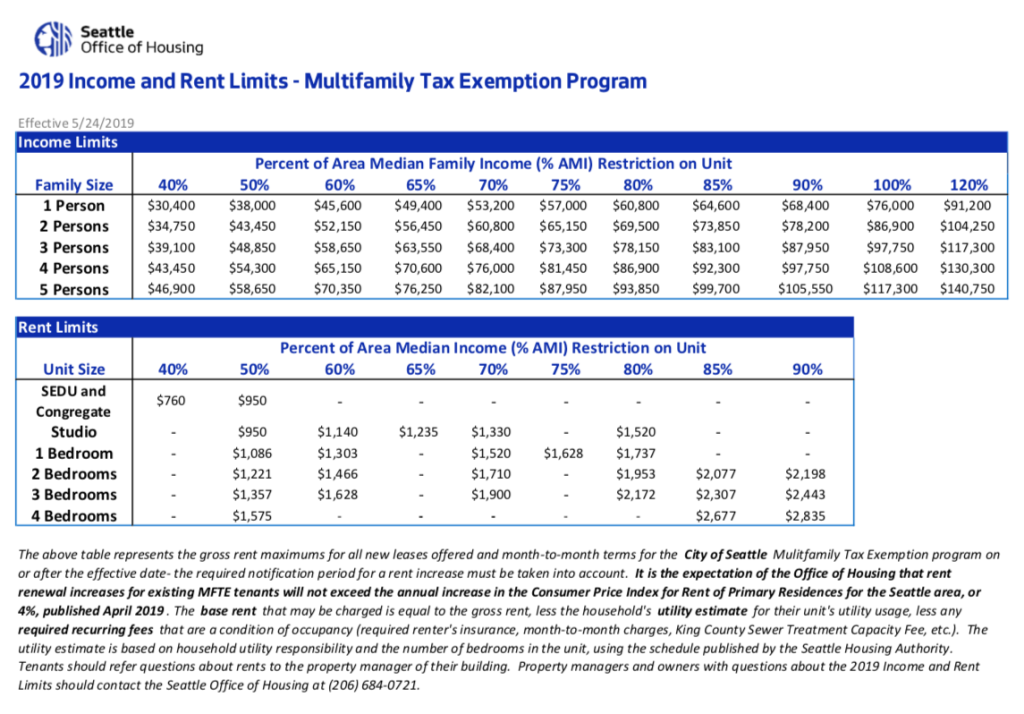
In the fine print beneath the MFTE table above, the Office of Housing writes that landlords are expected not to increase rents by more than the Consumer Price Index or 4% annually. However, Crosscut has reported that because of Seattle’s skyrocketing AMI, which has been propelled upward largely by technology sector jobs, renters in MFTE units have watched their rents increase at much higher rates, sometimes as high as 8% annually.
That makes the Mayor’s proposed 4.5% percent cap on rental increases sound like good news. Unfortunately, it appears that it will only apply to new MFTE units, and not the 4,500 existing units.
$50 million for supportive housing: a drop in the bucket when compared to the head tax
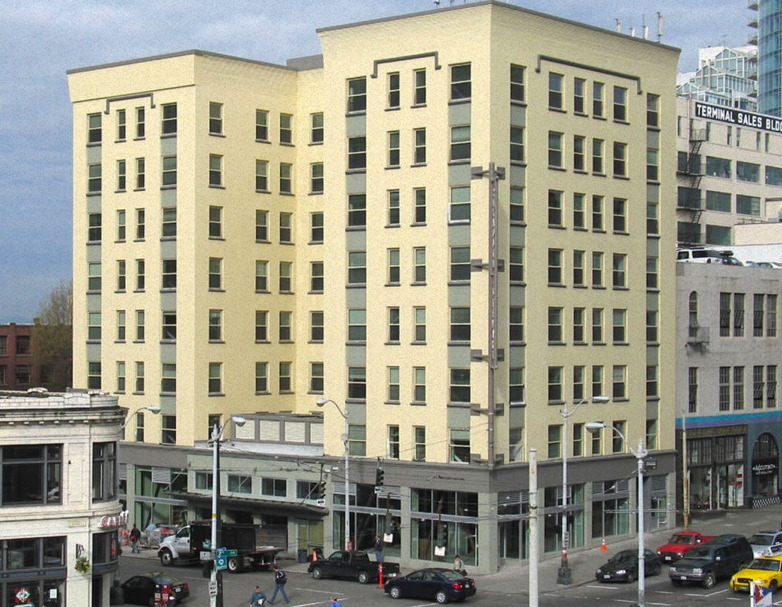
The City has been enthusiastic about the success of House Bill 1406, which allows cities to use sales tax proceeds to fund construction and operations of affordable housing. The law allows for cities to keep more of the sales tax revenue they are already earning, rather than raise a new tax. Mayor Durkan has announced her intention of being the first city in Washington State to capitalize on this new revenue stream to fund permanent supportive housing for people who have struggled with homelessness.
By bonding off 20 years of retained sales tax revenue, the Mayor said the City should be able to raise $50 million in dollars for permanent supportive housing, an amount that is roughly the same as what last year’s head tax, which was overturned by City Council under pressure from the Mayor, would have raised annually.
Permanent supportive housing is extremely effective at ending the cycle of chronic homeless by offering wrap around support services for residents, but cost of such services can be steep. In 2018, Plymouth Housing, which provides 1,050 units of permanent supportive housing in Seattle, spent $11.4 million on housing management and $16.2 million on social services for residents.
The Mayor must realize that $50 million raised over 20 years is a modest sum when compared to current needs. In fact in her own remarks, she boasted of having raised over $710 million for new low-come housing and middle income housing since 2017.
Big questions about Mercer Megablock
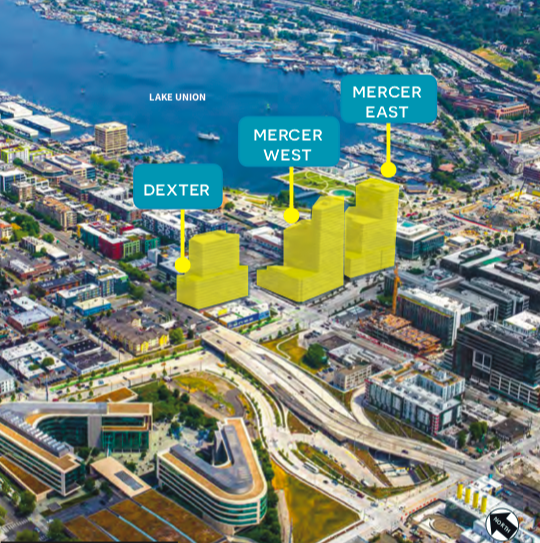
Mayor Durkan has also declared that it’s time to put the Mercer Megablock to work for Seattle. While details remain to be released, it appears that part of her plans for doing so entail the sale of the 2.86 acre parcel in South Lake Union, which has been roughly valued at $90 million. Last year after the City announced its intention to sell or lease the property, it released an RFP that asked prospective buyers to include 175 affordable units of rental housing. Considering 1,300 units of housing could be potentially built on the site, some affordable housing advocates were upset by the RFP and formed the Mercer Megablock Community Alliance, which has advocated for prioritizing affordable housing development at the site.
Since the Mayor announced the intentions of using proceeds from the Mercer Megablock sale for the City to “strategically” acquire properties near transit in high displacement areas for affordable housing development and finance low interest loans for construction of backyard cottages, it appears all but certain that the plan to sell the land is proceeding ahead.
That said Mayor Durkan has announced that more details about this “generational opportunity” will be released in the coming weeks, so the public should know soon exactly what role the Mercer Megablock will play in Seattle’s future plans for affordable housing.
Natalie Bicknell Argerious (she/her) is a reporter and podcast host at The Urbanist. She previously served as managing editor. A passionate urban explorer since childhood, she loves learning how to make cities more inclusive, vibrant, and environmentally resilient. You can often find her wandering around Seattle's Central District and Capitol Hill with her dogs and cat. Email her at natalie [at] theurbanist [dot] org.


